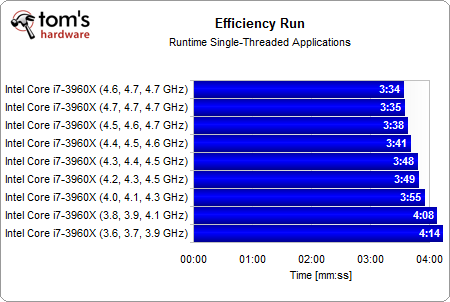Overclocking: Can Sandy Bridge-E Be Made More Efficient?
Intel's six-core processors are fast, but enthusiasts almost always want to push unlocked multipliers harder. Core i7-3960X can easily exceed 4 GHz, but what happens to power efficiency when clock rates go up? Sandy Bridge-E demonstrates weaknesses there.
Efficiency: Single-Threaded (One Core Active)
The above chart shows the total time for running all of our single-threaded benchmarks. As a result, the only clock rates that apply are the ones on the right-hand side of the Turbo Boost frequencies, from 3.9 to 4.7 GHz. The maximum overclock saved time to the tune of 16%, but clock rate had to increase by more than 20% in order to get there.
The average amount of energy required for the operation climbed by a more staggering 40% or so.
Because we don't test with a ton of single-threaded software, our scripted benchmark doesn't take long to complete. The total energy requirement at stock clocks was just 7.2 Wh. The most aggressive overclock came in at 8.3 Wh. Multiply those numbers out over hours, days, weeks, and months, though, and you get a better sense for how this could impact your power bill.
Get Tom's Hardware's best news and in-depth reviews, straight to your inbox.
Current page: Efficiency: Single-Threaded (One Core Active)
Prev Page Power Consumption Next Page Efficiency: Multi-Threaded (All Cores Active)
Patrick Schmid was the editor-in-chief for Tom's Hardware from 2005 to 2006. He wrote numerous articles on a wide range of hardware topics, including storage, CPUs, and system builds.
-
Yargnit What about trying to under-volt it at slight under-clocks to slight-overclocks. How much room is there to reduce it's stock voltage to gain better efficiency?Reply -
billj214 Was there an efficiency chart made for the Core i7 2600k or 2700k?Reply
Nice to know Intel doesn't just set the stock clock speed for just performance! -
Marcus52 ReplyAnd then there's the Core i7-3820, which only sports four cores, but operates at a base clock rate of 3.6 GHz. Although this less-complex chip could probably hit higher Turbo Boost frequencies, Intel limits it to 3.9 GHz to keep it from outshining the top-end Core i7-3960X in single-threaded tasks.
Did someone at Intel tell you that was the reason for a lower Turbo Boost limit, or did you just assume it?
I think we should be careful of this kind of guess at another person's, or company's, reasoning. There could be some other cause for the limit - for example, they will obviously sell it for a lower price, so wouldn't a possible reason be they have looser binning specs to allow for chips that wouldn't make it under more strenuous tests through? (Remember, Intel, or any CPU manufacturer, doesn't warrant the product based on what it can be pushed to, and is generally going to provide it at a clock rate they feel is safe over time to guarantee.)
I'm certainly not saying it is a bad assumption, what you said makes sense to me, but I do think there are enough other reasonable possibilities that I wouldn't have stated it as a fact unless I knew it to be.
;) -
Marcus52 Thanks for the analysis!Reply
I do think articles like this are very important; those of us who overclock, especially when we turn off all the power-saving features in hopes of reaching that max stable a CPU can do, should be aware of how much money we are spending if we keep said OC. It's more than just the high end cooling solution.
The people that bash higher capacity PSUs could also stand to learn a thing or two, here. An overclocked CPU can require a huge amount of peak power over and above what a stock CPU needs (349W measured here). An overclocked Sandy Bridge-E and an overclocked GTX 580 could require a peak power of 650W just considering those 2 components!
A Kill A Watt or similar device is a great way to measure how much you actually spend a month operating your computer. You might be surprised.
;) -
giovanni86 Just a thought, so at 4.7Ghz the performance increase was only 16%? For being such a High overclock i was hoping for more then that. You guys literally upped the bar from stock clock to the OC clock by 1.4ghz, seems like a small increase in performance if you look at the amount of watts it takes.. Well at least its good 2 know my future billing of electricity will sure be expensive.. =PReply -
cangelini Marcus52Did someone at Intel tell you that was the reason for a lower Turbo Boost limit, or did you just assume it?I think we should be careful of this kind of guess at another person's, or company's, reasoning. There could be some other cause for the limit - for example, they will obviously sell it for a lower price, so wouldn't a possible reason be they have looser binning specs to allow for chips that wouldn't make it under more strenuous tests through? (Remember, Intel, or any CPU manufacturer, doesn't warrant the product based on what it can be pushed to, and is generally going to provide it at a clock rate they feel is safe over time to guarantee.)I'm certainly not saying it is a bad assumption, what you said makes sense to me, but I do think there are enough other reasonable possibilities that I wouldn't have stated it as a fact unless I knew it to be.Hence the "probably." Of course, we don't know for sure, nor would Intel ever admit as such, but it's an educated guess nonetheless. =)Reply


